The Comte de Grasse, the one born in 1722 with the given names of François Joseph Paul, was an admiral in the French navy prior to the French Revolution. In fact, this Admiral de Grasse (in French the “Amiral” de Grasse) was the commander of a French naval fleet that played an instrumental role in the victorious ending of the American Revolutionary War against the British. It is by happenstance that a statue in his memory, located in a somewhat isolated part of a plaza in the town of Grasse, France, where we live, has triggered an adventure in search of discovering how his role has been memorialized where it actually was played out – that is, in and around the Chesapeake Bay and the town of Yorktown in the State of Virginia. I recently had the opportunity to engage in this search, largely motivated by what one might do to memorialize more respectable war heroes, like this one, in stark contrast to the disturbing array of the Confederate generals whose statues permeate that very same State, including the especially infamous Monument Avenue of the State’s capital of Richmond (to say nothing about the controversy over the statue of Robert E. Lee in Charlottesville, Virginia).
By way of background, on March 8, 2019, International Women’s Day, I went to the Palais des Congrès in Grasse for an all-day session on women in the perfume industry. As reported in a “musing” that I wrote shortly after that event (available http://katherinehagen.net/perfumerie-and-parasols-on-international-womens-day-2019-in-grasse-france/), I learned a lot about the interplay between the revival strategy of local authorities to bring Grasse back into the mainstream of perfumerie in the world today and the emerging opportunities for women to succeed in this ironically male-dominant industry. I only start this latest musing on “Searching for the Comte de Grasse in Yorktown” with a reference to this event because it was on this occasion that I chose to take a break from the rapid and highly specialized French that I was having difficulty absorbing at this symposium. I slipped outside the Palais for a few minutes of fresh air and quiet reflection in the plaza just across the street.
Lo and behold, I wandered over to the odd looking statue that I had frequently passed by on previous visits to the plaza. The plaza (known, by the way, as the Cours Honoré Cresp) has a stunning view of the Mediterranean Sea in the distance, and the sea had always been more of an attraction for me than this odd statue. But this time, the sea view was hazy, and I turned my attention to the statue. My goodness, I saw on the plaque under this strange fellow with his arm stretched out in an imposing gesture, that he was the “Comte de Grasse”.
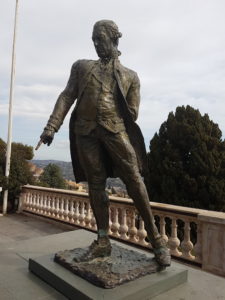
Fair enough, I suppose, to have a statue here of a French aristocrat associated with the town’s name, even if France is well beyond those aristocratic days. But reading further on, the plaque described him as “l’un des artisans de l’independence des Etats Unis d’Amerique”. How intriguing! An “artisan”, with aristocratic roots no less, of the independence of the United States? And on another plaque under the same statue, there was the phrase “Vous avez été l’arbitre de la guerre », documented right there on that plaque in the form of a quote – from none other than the very American George Washington. So George Washington was quoted as saying that this fellow the Comte de Grasse “was the arbiter of the war”. Arbiter? War? The American Revolutionary War? Comte de Grasse? Artisan?
Learning about the Comte de Grasse
My curiosity was piqued. Forget International Women’s Day and women in perfumerie. Let’s go macho and see what this Comte de Grasse – also described as the “Amiral de Grasse” – supposedly did to earn the moniker of “arbiter” of, presumably, that famed American Revolutionary War that enabled the independence of the United States of America, way back in 1781. I was indeed astonished to discover in my Internet search of the name that this Amiral de Grasse was actually a navy admiral who commanded a fleet of French battleships whose defeat of a British fleet near Chesapeake Bay in September 1781 ultimately determined the outcome of the war. The surrender of the British General Cornwallis in Yorktown didn’t just happen because the British were outnumbered on the land. Rather the surrender happened because the escape route for Cornwallis and his troops was effectively blocked by the Admiral de Grasse and the French fleet in the Chesapeake Bay.
Well, well, well. What a discovery! In all my lessons on American history, I had known about the definitive Battle of Yorktown where Cornwallis surrendered. And I knew that the Continental Army under George Washington had received significant help from the French – the name of Marquis de Lafayette immediately comes to mind. But a French naval fleet? In the Chesapeake Bay? With an admiral who came from Grasse? A town on the Riviera known as the perfume capital of the world but not as the hometown of a key figure in the American Revolutionary War?
So it turns out that this guy was a big deal. Well, that should be in the past tense. It didn’t just turn out that the Comte de Grasse was a big deal. He was a big deal all along – in all of the history books, as it were, and truly an enabler (arbiter?) to the end of the American Revolutionary War. It’s just that most of us in our school-day lessons had not paid any attention to the considerable array of contributions from the French (and others from Poland and Germany and elsewhere) in enabling the defeat of the British in the Revolutionary War. We knew about Lafayette, to be sure. His name permeates the American landscape with towns, counties, highways, parks, streets and you name it, but de Grasse? Maybe someone like the Comte de Rochambeau, who was Lafayette’s superior in all of this. But the name of the Comte de Grasse was a revelation.
Take note: Lafayette Square is just across from the White House in Washington, DC, a park populated with the statues of many (foreign) military figures from the Revolutionary War – including Lafayette, of course, but also the Comte de Rochambeau, another French commander who fought with George Washington in Yorktown – but not the Admiral de Grasse.
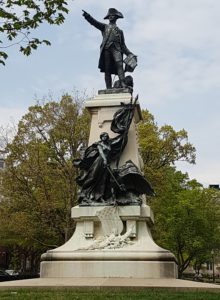
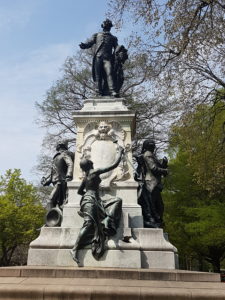
Instead there are statues of German and Polish heroes from the Revolutionary War (a true reflection of multilateralism), and at the center a statue of former President Andrew Jackson (unrelated to the rest).
Anyway, back to the Comte de Grasse: This discovery about his role in the Battle of Yorktown proved to be a convenient opening for incorporating French figures into my teaching of English to French adults in neighboring Peymeinade, a village just at the edge of Grasse. My students and I learned together about the role he played as an accomplished naval commander to outwit and overpower the British fleet that was supposed to support Cornwallis in Yorktown. We also learned, of course, about both Lafayette and Rochambeau whose French troops that joined with the Americans in Yorktown, but it was especially interesting to learn about the Admiral.
We still kept a special place for the Marquis de Lafayette because he was in charge of an advance force of French soldiers that skirmished with the British in Virginia prior to the main event. And, of course, I reaffirmed in our English class in Peymeinade, that American history lessons had a lot to say about Lafayette but not much about these others. Maybe it’s because the Comte de Grasse died a few years later in 1788 and the Comte de Rochambeau died in 1807, while the Marquis de Lafayette lived until 1834 and actually participated in a grand 50-year anniversary return tour of the States in 1828. Nonetheless, the discovery stimulated me to explore the ways that Americans have themselves memorialized these other important French figures – and especially the Comte de Grasse.
Searching for the Comte de Grasse in Yorktown
On a recent visit to the States, I made sure to set aside a day to visit Yorktown – for the first time. Oddly enough, I had been to many parts of coastal Virginia in the past but never to Yorktown. I wanted to see the terrain of the famous battle that ended the Revolutionary War, as well as the links to the “Battle of the Capes”, as the battle to free up the Chesapeake Bay had been called – i.e. the one that had been commanded by the Comte de Grasse. I had read that there was even a parallel statue of the Comte de Grasse somewhere in the area, comparable to the one that I had come to appreciate in the town of Grasse itself.
 So off we went to Yorktown, my daughter Kristina and son-in-law Julian leading the way. First, we discovered that there were TWO historic Yorktown tourist facilities. We first went to the American Revolution Museum in Yorktown, but we concluded that this was not what we were looking for. We wanted to see the actual battlefield. And oh my, we discovered that this was separate from the museum, which is itself a State of Virginia operation, whereas the battlefield is the Colonial National Historical Park Virginia, run by the National Park Service of the US Department of the Interior. And, of course, the town of Yorktown is another thing entirely – clearly the historic location of the battle and associated with the National Park Service, but still operating as a (very small) functional town with real life inhabitants.
So off we went to Yorktown, my daughter Kristina and son-in-law Julian leading the way. First, we discovered that there were TWO historic Yorktown tourist facilities. We first went to the American Revolution Museum in Yorktown, but we concluded that this was not what we were looking for. We wanted to see the actual battlefield. And oh my, we discovered that this was separate from the museum, which is itself a State of Virginia operation, whereas the battlefield is the Colonial National Historical Park Virginia, run by the National Park Service of the US Department of the Interior. And, of course, the town of Yorktown is another thing entirely – clearly the historic location of the battle and associated with the National Park Service, but still operating as a (very small) functional town with real life inhabitants.
At the welcome center for the Colonial National Historical Park, we enjoyed a short film and a series of window displays of the area in colonial times and the battle lines. We learned a lot about the actual nature of the battle – very little direct combat but mostly lobbing cannon fire at each other. The Americans and French were able to maneuver closer to the entrenched position of the British with more firepower, and Cornwallis ultimately had to opt for surrender or slaughter, since those French ships under Comte de Grasse’s command had closed off a retreat to the rear. There was also a walking tour of the battlefields themselves.
We then continued our tour by walking through the town itself. There was a big monument, called the Yorktown Victory Monument and a variety of other historic structures that had retained evidence of battle damage (yes, even from Revolutionary War days, it seems). But the town itself was rather quiet. One of the historic streets was named Comte de Grasse Street. Good enough!

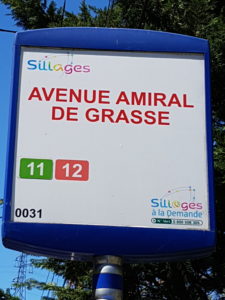
Just like we have a street named Avenue Amiral de Grasse back home! So we were inspired to keep on in our search for the famed statue.
As we walked in the chilly wind and bright sunshine, on down to the riverfront landing, we kept our eyes open. And there it was!
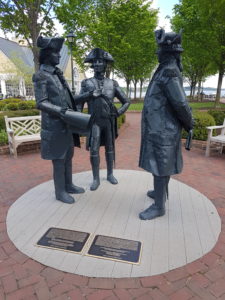
A three-person statue of relatively contemporary style, depicting the meeting of General Washington and Lafayette with the Admiral de Grasse on his ship, as they reviewed the strategy for the battle against Cornwallis. It was indeed an impressive statue, and we duly took photos. But that was not the one I had read about. There was supposedly some other statue of the good Admiral, one that seemed to be overlooking the Chesapeake Bay itself, not just tucked away in a corner of a riverfront landing.
The Cape Henry Adventure
No one in the area seemed to know about this other statue of the Comte de Grasse, but an Internet search by my son-in-law Julian determined that it was not in Yorktown itself. Rather, it was near the Cape Henry Lighthouse in Virginia Beach, some hour away by car. Not to be giving up at this point, my daughter Kristina boldly concluded that we just had to go there, since we had come this far. So off we went in search of the legendary statue of the Comte.
In retrospect, a further Internet search has verified that this particular statue is indeed maintained by the same Colonial National Historical Park under the National Park Service as the Yorktown site, even though it is nowhere close to Yorktown. It is located at the Cape Henry Memorial, inside the Joint Expeditionary Base East, in Virginia Beach. Little did we know, since no website information was immediately forthcoming about this, that this was a real military base! The website information only said that the site was open daily between 9 am and 5 pm. Although it took us an hour and a half to get there in the heavy traffic to Virginia Beach, we finally did arrive at the entrance to this Joint Expeditionary Base East at just before 4 pm. Enough time to slip in, get a glimpse and a photo of the statue and call it a day.
Oh well, we found out otherwise. The entrance had military guards! We hesitated but then hung in there. This was a statue in a national park, after all. And I even had a new lifetime senior pass valid for all national parks in the country. After other vehicles ahead of us had been processed by these guards, we finally got to the gate and explained that we were there to enter the national park at Cape Henry. The guard said no way, no citizens are allowed into the base. Yes, he said, the Cape Henry Lighthouse was in the base, but no citizens were allowed. We explained that we were only there to take a look at this particular statue of the Comte de Grasse. Who? The guard had no idea what we were talking about. Statue? Comte de who? We explained that we had driven a long distance to see the statue. He then asked us if any of us were veterans or immediate relatives of veterans. Well, we looked around at each other – didn’t think to mention World War II veterans (a father and a grandfather) or cousins or uncles. No immediate veterans. I then said but I have this senior national park pass. The guard, to be generous, did pause at that point, but to no avail. No entrance allowed.
OK, we said, we will back up and leave. But no, said the guard, you are not allowed to back up out of here. You must go in and park inside the base at the adjacent parking lot and wait. Wait for what, we wondered. Sure enough there was a long line of cars on the road inside the camp, waiting to be allowed out of the camp. Apparently, only at a fixed hour can anyone leave, regardless of whether they are veterans or not. So we waited, not knowing quite what else to do. Eventually, of course, the guards let us drive out. That was when my daughter and son-in-law started to howl with laughter about my offer of a senior national park pass to the humorless guard.
We did not give up, though. We knew about another entrance to the park (and base) and drove there in hopes that we could get in before the 5 pm closing. But when we got to that entrance, another military guard said that the only way we could enter was through the base entrance where we had been turned away. His explanation was that civilians were allowed into the base to go to the Cape Henry Lighthouse but only between 10 am and 3 pm. He, too, did not know anything about a statue. But that was the end of our efforts – whether the civilian hours were as he said or no civilians allowed as the previous guard had said. It became clear to us that no other options were available for us to capture a photo of this unknown statue on this particular venture. So we went shopping instead (at a conveniently located outlet mall on the way back to Richmond) and kept on laughing about the naiveté of offering a military guard a senior national park pass to get into a military base.
Follow-up research on the Internet shows a variety of inconsistent policies regarding access to Cape Henry. One source says that it is a national park open daily from 9 am to 5 pm. Another dated source (2018) says that one can only enter through that one main entrance and one must park ones’ vehicle (at supposedly that parking lot where we were directed to park and wait) and wait for a shuttle bus to get to Cape Henry itself. Yet another source states that it is indeed in a military camp and that there may be unannounced times when the park will be closed for whatever military emergencies that a military camp might need to be closed to civilians.
What it amounts to is that this particular statue of the Comte de Grasse is not exactly a popular tourist attraction. We do know people in the past who have made a point of going out to visit the Cape Henry Lighthouse, which is itself a well known historic site. But the fact is that both the monument to commemorate de Grasse and his sailors at the Cape Henry Memorial and the Cape Henry Lighthouse are so unreliably accessible that they aren’t reasonable tourist attractions today. The lighthouse is not very movable, but maybe one might consider moving the monument honoring the Comte de Grasse and his sailors to a more accessible location. Of course, the drawback is that the Comte de Grasse isn’t that well known. There just aren’t that many people living in Grasse who have been turned on, as I was, by the discovery of the connection between de Grasse and the American Revolutionary War.
The Broader Issue of Statues
Memorials and statues of historical figures are themselves problematic these days, especially in the State of Virginia. The Confederate statues on prominent display in places like Monument Avenue in Richmond, the State capitol and the former capital of the Confederacy, are an affront to those of us who seek to unite, not divide, the American people – and to unite all people across the world. And it is ironic that the one statue of Abraham Lincoln that one finds in Richmond is hidden from view in the back patio of a riverside museum. Of course, there is an even more fundamental problem with these more visible statues (whether of heroes or of figures associated with a flawed cause) in that they are almost all honoring white men – most of them in uniform (with the exception of a few presidents). What a history! That is to say, no herstory at all, to speak of, and very limited ethnic diversity, too.
Richmond did, indeed, finally add a statue of Arthur Ashe on Monument Avenue, and there is a wonderful statue honoring Barbara Rose Johns and the people who joined with her in 1951 to challenge the segregated school system in Farmville, Virginia. That challenge, by the way, became one of the cases that were joined together into Brown versus Board of Education, in which the US Supreme Court ended segregation under the law in 1954. The statue of Barbara Rose Johns is part of the Virginia Civil Rights Memorial, on the Capitol Grounds in Richmond. The memorial is actually a collection of 18 statues some depicting known individuals like Barbara Rose Johns but others representing the students and the adults who joined her in the historic challenge. To expand our search for memorials beyond the ones associated with the Battle of Yorktown, we went to see that one too, along with another memorial to women on the same Capital Grounds, This one is free of any statuary accolades. There is an even new Virginia Indian Tribute! Also free of statuary.
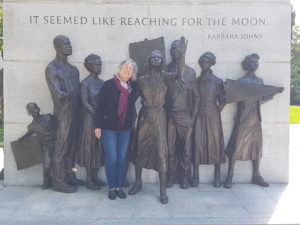
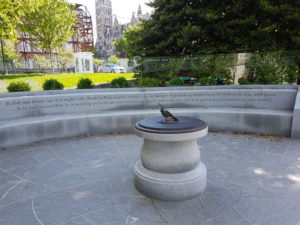
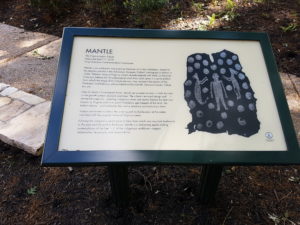
So things, they are achanging, even as we deal with regressive and dangerous actions by some key decision-makers today. It is possible to appreciate the history of past accomplishments even where they aren’t entirely pure. Revolutionary War heroes are OK to leave in public places (and preferably accessible ones, unlike the Cape Henry Memorial), even if Confederate statues should be relegated to museums where one can appreciate their historic value without memorializing their faulty deeds. I would love to see the Cape Henry statue honoring the Comte de Grasse (and his sailors) placed somewhere comparable in Virginia to his statue on the very open and public plaza of Grasse itself. And this is so, even if he was an aristocrat, a soldier and a white male whose immediate descendants were both slave-owners in the Caribbean, in the case of one son, and a path-breaking physician of mixed race progeny, in the case of another. He did, after all, play that marvelous role of “artisan” and “arbiter” to help achieve independence for the United States and thus to enable the beginning of the major experiment in democracy that has flourished as a result.

